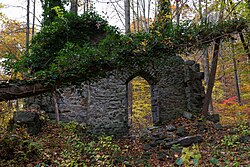This article needs additional citations for verification .(April 2022) |

The following is an incomplete list of ghost towns in Maryland. Ghost towns can include sites in various states of disrepair and abandonment. Some sites no longer have any trace of civilization and have reverted to pasture land or empty fields. Other sites are unpopulated but still have standing buildings. Some sites may even have a sizable, though small population, but there are far fewer citizens than in its grander historic past.
Contents
- Classification
- Barren site
- Neglected site
- Abandoned site
- Semi abandoned site
- Historic community
- List by County
- Baltimore City
- Baltimore County
- Calvert County
- Cecil County
- Charles County
- Frederick County
- Garrett County
- Harford County
- Howard County
- Prince George's County
- Queen Anne's County
- Somerset County
- St. Mary's County
- Washington County
- Worcester County
- See also
- Notes and references
Many ghost towns can be located in the Appalachian counties, particularly Garrett County. During the 18th and 19th century, a number of "boom towns" were formed to participate in the flourishing coal, railroad, and iron industries. Towards the late 19th century, the resources in the region had begun to deplete, and the onset of the Great Depression finally killed many of the industrial towns. [1]


